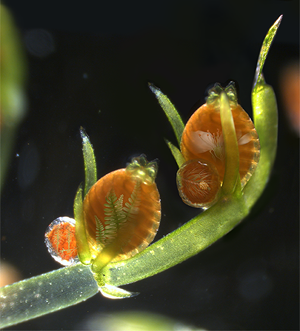International Collaboration Finds Land Plant Genes in Ancient Aquatic Alga
Newly sequenced algal genome shows that adaptations essential for land plants evolved before land plants did
Land plants, which split from their aquatic relatives 500 million years ago, are an extraordinarily diverse group of living organisms—from tall redwoods to fragrant roses to carpets of moss.
 For plants, survival on dry land required some new evolutionary innovations. For instance, they had to develop root systems that can absorb nutrients from soil. They also needed strong stems that can support their own weight without help from the buoyancy of water. Land plants evolved to deal with these and many other environmental challenges, resulting in their worldwide abundance today.
For plants, survival on dry land required some new evolutionary innovations. For instance, they had to develop root systems that can absorb nutrients from soil. They also needed strong stems that can support their own weight without help from the buoyancy of water. Land plants evolved to deal with these and many other environmental challenges, resulting in their worldwide abundance today.
To better understand the genetic adaptations that made this transition so successful, an international team, which included three University of Maryland researchers, sequenced and analyzed the genome of Chara braunii, a freshwater green alga closely related to land plants. By comparing Chara’s genome to multiple land plant genomes, the team was able to identify many important genes that originated in a common ancestor shared by Chara and land plants.
The research paper was published in the journal Cell on July 12, 2018.
“It’s great to finally have a genome from an alga closely related to land plants,” said UMD Cell Biology and Molecular Genetics Professor Charles Delwiche, an expert in plant evolution. “This information will help us understand which land plant functions were truly novel.”
Chara braunii belongs to a division of plants called Charophytic algae, which are the closest living relatives of land plants. As one of the first Charophytic algae to have its genome sequenced, Chara has yielded important information on how land plants evolved from their aquatic ancestors.
"Our data show that a number of genes previously considered typical for terrestrial plants can already be found in these algae," said Stefan Rensing, a professor of cell biology at the University of Marburg who led the collaboration. “This means that some important processes that occur when land plants grow are much more ancient than previously believed. In fact, some of these characteristics evolved before land plants even existed.”
For example, Chara possesses all of the genes required to detect the presence of the plant hormone ethylene. This ability is present in all land plants where ethylene plays a wide variety of roles, from promoting seed germination to signaling when fruit should ripen.
“Given the huge number of roles ethylene has in plants, we want to know when the ethylene signaling pathway originated,” said Caren Chang, a professor in the UMD Department of Cell Biology and Molecular Genetics and an expert in ethylene signaling in plants. “Because we found that Chara has all of the specialized genes for ethylene signaling, it means that this ability is even older than Chara.”
Although Chara can respond to ethylene, the scientists also discovered that Chara lacks key steps of the cellular pathway needed to make the hormone. Chang’s laboratory is currently investigating the evolution and function of the incomplete ethylene-making pathway in Charophytic algae and in some land plants such as mosses, liverworts and ferns.
Some other features that Chara shares with land plants include: egg and sperm cells, which allow plants to make seeds that can disperse over land; tip growth, which allows plants to develop complex roots to get nutrients out of soil; and some of the cellular machinery important for formation of the plant cell wall, which allows plants to support their own weight.
Going forward, Delwiche plans to sequence the genomes of other Charophytic algae that are more distantly related to land plants.
“One really cool thing about having complete genomes is that you can start to understand what bits and pieces and systems are missing,” Delwiche said. “Identifying which genes are missing, and in which species, will give us insights into how plants evolved.”
###
Other study co-authors affiliated with UMD include postdoctoral scholar John Clay (Ph.D. '18, biological sciences).
This work was supported by the Japanese Ministry of Education, Culture, Sports, Science and Technology (MEXT) and the Japan Society for the Promotion of Science (JSPS) Grants-in-Aid for Scientific Research (KAKENHI) (Award Nos. 17020008, 20017013, 22128008, 24370095, 22770083, 24570100, 15K07185 and 221S0002); the Hyogo Science and Technology Association; the German Research Foundation (DFG) (Award Nos. GO1825/4-1, CRC1208, VR 132/1-1, SFB 944, FOR964 and SFB 924); the Ministry of Education, Youth, and Sports of the Czech Republic (MEYS) (Award No. LO1417); the Carlsberg Foundation and the Villum Foundation's Young Investigator Programme; the Plant Research Laboratory (LRSV) (Award No. ANR-10-LABX-41); Gent University; Research Foundation Flanders (Award Nos. G.0317.17N and 1S17917N); the European Research Council (ERC) Advanced Grants (Award No. EVO500); the Leibniz Association; and the National Science Foundation (Award Nos. DEB-1020660, DEB-1036466, MCB1714993 and DEB 1036506).
This news release was adapted from text provided by the University of Marburg.
The research paper, "The Chara genome: secondary complexity and implications for plant terrestrialization," Tomoaki Nishiyama et al., was published in the journal Cell on July 12, 2018.
Media Relations Contact: Irene Ying, 301-405-5204, zying@umd.edu
University of Maryland
College of Computer, Mathematical, and Natural Sciences
2300 Symons Hall
College Park, MD 20742
www.cmns.umd.edu
@UMDscience
About the College of Computer, Mathematical, and Natural Sciences
The College of Computer, Mathematical, and Natural Sciences at the University of Maryland educates more than 9,000 future scientific leaders in its undergraduate and graduate programs each year. The college’s 10 departments and more than a dozen interdisciplinary research centers foster scientific discovery with annual sponsored research funding exceeding $175 million.


